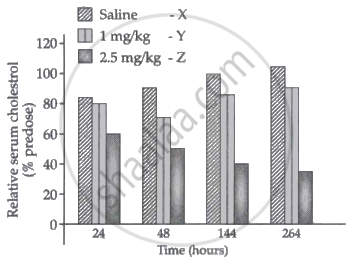Advertisements
Advertisements
प्रश्न
Crystals of Bt toxin produced by some bacteria do not kill the bacteria themselves because −
विकल्प
bacteria are resistant to the toxin
toxin is immature
toxin is inactive
bacteria encloses toxin in a special sac.
उत्तर
Toxin is inactive
Explanation:
Bacillus thuringiensis produces protein crystals during a particular phase of its growth. These crystals have a deadly insecticidal protein. The Bt toxin protein exists as inactive protoxins; however, when an insect consumes the inactive toxin, it is transformed into an active form of toxin due to the alkaline pH of the insect stomach, which solubilises the crystals. The active toxin adheres to the surface of midgut epithelial cells, causing cell swelling and lysis, eventually leading to the insect's death, although it does not harm Bacillus.
APPEARS IN
संबंधित प्रश्न
Which part of the plant is best suited for making virus-free plants and why?
What is the major advantage of producing plants by micropropagation?
What are Cry proteins?
List any five possible advantages of a GMO to a farmer.
How has the use of Agrobacterium as vectors helped in controlling Meloidogyne incognita infestation in tobacco plants? Explain in the correct sequence.
Answer the following question.
How is a continuous culture system maintained in bioreactors and why?
Answer the following question.
List one advantage and one disadvantage of an apomictic crop.
A cell swells up when kept in:
Bt Cotton is resistant to ______.
Which one of the followmg bacterium is used for the production of transgenic plants?
A protoxin is ______.
Bt toxin obtained from ______.
Golden Rice:
A. GM rice
B. Rich in Vit A
C. Prevents blindness
D. Bruise resistant
Silencing of a gene could be achieved through the use of ______.
Gene expression can be controlled with the help of RNA. Explain the method with an example.
|
RNA interference (RNAi) holds great potential as a therapeutic agent for the treatment of human diseases and as biocontrol agents in controlling pests in the field agriculture. An experiment was carried to study the use of 'RNAi' for the potential treatment of disorders of cholesterol metabolism. Some people possess genetic mutations with elevated levels of ApoB gene which predisposes them to coronary artery diseases. Lowering the amount ApoB can reduce the number of lipoproteins and lower the blood cholesterol. Tracy Zimmerman and her colleagues used RNAi in 2006 to reduce the level of ApoB in non human primates Cynomolgus monkeys. One group of monkeys were given RNAi treatment (small interfering RNAs, SiRNAs) (doses 1 mg/kg, SiRNAs), second group of monkeys were given RNAi treatment (doses 2.5 mg/kg, SiRNAs) and third group of monkeys were injected with saline. |
The results of the study are depicted in the graph below:

- How does the treatment with 2.5 mg/kg bring an effect on cholesterol metabolism when compared from 24 hours and 144 hours?
- Write any two natural sources from where dsRNA molecule could be obtained for silencing the specific mRNA.
- How is RNAi used in controlling the infection on the roots of tobacco plants by the nematode Meloidogyne incognitia?
"RNA interference has been used to produce transgenic tobacco plants to protect them from the infestation by specific nematodes." Explain the novel strategy exploited by the biotechnologists.
Name an organism that produce cry proteins.
